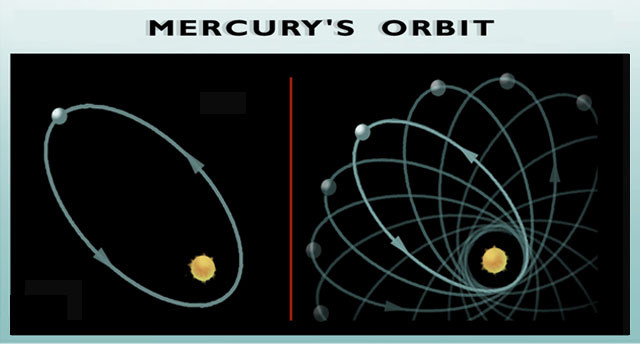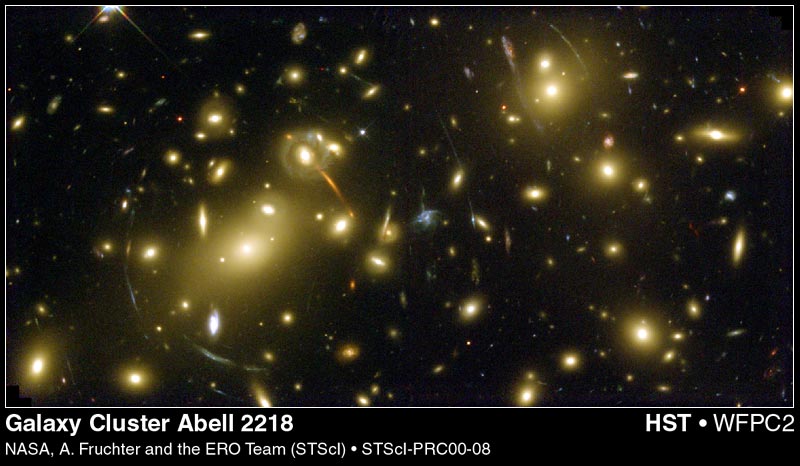General Relativity A
THE NEED TO GO BEYOND SPECIAL RELATIVITY
Special Relativity deals only with the effects of relative motion at constant velocity. If one reference frame speeds up or slows down, or rotates, relative the other frame, the predictions of SR can no longer be trusted. This is a serious limitation, one which Einstein labored another 10 years to overcome. In 1915 he published the General Theory of Relativity. GR is Einstein’s theory of physics in accelerated (non-inertial) frames, and equivalently, in gravitational fields.
There are two sets of facts that lead Einstein on the path to General Relativity. I will call them Hint #1 and Hint #2.
Hint #1: Gravity is indistingishable from being in an accelerating frame. Imagine you’re in a room with no windows. If you are on Earth, the floor is pushing up on you with FN=mg, to keep you from falling though the floor. Now, imagine instead that the room is in space, far from Earth's or any other planet, so there is no gravity. If the room is accelerating at 9.8 m/sec2 (let's say it has a big rocket engine on it) the floor is also pushing on you, with FN= ma = mg, as is necessary to accelerate you (counteract your inertia) and keep you from passing through the floor. You, inside this windowless room, cannot tell whether you're on a planet with gravity, or if you are in gravity-less space, but accelerating.
Conversely, freely-falling frames appear inertial to those inside. In other words, if you are in a room on the Earth that is falling freely (imagine an elevator after the cables break and the saftey brakes fail) you will feel as if there is no gravity. The floor will not be pressing up against your feet as you are used to. To an outside observer, it’s accelerating.
This equivalence is predicated on the equivalence of gravitational mass and inertial mass. That is, the m in F=ma and F=GMm/r2 are the same. Perhaps this seems unremarkable, but that is only because we’ve used the same letter to represent both. The Universe didn’t have to work this way. When Newton was working this out, there was no reason to assume they were the same. Nevertheless, his own experiments showed that they were the same, to an accuracy of 1 in 1000. Experiments of incredible precision (1 in 1011) have since been performed to verify this equivalence. Einstein elevated this equivalence from coincidence to postulate. In fact, it's called the equivalence principle: being in a gravitational field is indistinguishable from being in an accelerating (non-inertial) reference frame.
Hint #2: All other forces (electromagnetism, weak, strong) work on some particles and not others. The strong force only operates between nucleons; the electromagnetic force only with particles we call ‘charged’. Gravity works on all of them, so it might not be a property of the particles, but rather an effect of the space in which the particles exist.
The conclusion that Einstein came to was that gravity is caused by the bending (or warping) of both space and time. What causes the bending: the prensence of mass. Freely moving objects are following the curvature of space, not a ‘force’ we call gravity. Take a planet orbiting the Sun as an example. The planet is moving because of its inertia. As far as the planet is concerned, it is just drifting; the reason its path is curved is because the space itself is curved.
The curvature of space is difficult to visualize. You have to be able to envision a fourth dimension, which most people (Einstein included) have troubles doing. Instead, let's pretend that we are 2-dimensional creatures living on the surface of a trampoline. Imagine also that there is a heavy bowling ball sitting on the trampoline, curving it into a third dimension that we 2D creatures don't even know about. Something sliding on the trampoline near the bowling ball will curve around it. To us 2D creatures, it appears that there is a force between the ball and the sliding object, and we might even call this mysterious force "gravity".
Another of Einstein's conclusions was that mass causes time to slow down. This is usually stated as "gravity slows down time", but really the mass causes the both gravity and the slowing of time.
BASIC RESULTS & EXPERIMENTAL CONFIRMATION Here are some interesting side effects and applications of GR.
Precession of Mercury's Orbit. Since the 1850s there was a serious mystery in the field of astronomy: the odd orbit of Mercury around the Sun. According to Newton’s laws, a lone planet in orbit around the Sun takes the path of an ellipse, and it should retrace the same ellipse over and over again. But Mercury doesn’t do this — its orbit slowly rotates, or precesses. Actually, because of the gravitational pull of the other planets, one would expect the orbit to precess about 1.542 degrees per century. But Mercury precesses 0.012 degrees/century more than this, and this excess can’t be accounted for with Newtonian gravity. This discrepancy in the precession took a long time to notice, because making that kind of accurate orbit measurement required the advance of technology, and the accumulation of data, for many decades after Newton’s time. Astronomer U.J.Leverrier hypothesized that another planet existed, inside the orbit of Mercury. He even named it: Vulcan, after the Roman god of fire and metallurgy. This unseen planet's gravity must be causing the troublesome 0.012 degree/century precession of Mercury, went the reasoning. This is a very sound idea — Neptune was discovered, by Leverrier in 1846, because he noticed its effect on the orbit of Uranus. Several astronomers, amateur and professional, believed that they saw Vulcan pass in front of the Sun, but these sporadic sightings were never consistent with each other and the idea of Vulcan eventually died out. With the development of General Relativity, the equations of GR fully account for the previously-unexplained precession of Mercury's orbit. Einstein's relativity fully explains the precession of Mercury's orbit — there is no reason to suspect another planet such as Vulcan as the cause. This was the first great experimental confirmation of GR.
Gravitational Lensing. Gravity bends light. This was first confirmed by experiment in 1919 during the May 29 total solar eclipse. Astronomers were able to measure how much stars, visible in the daytime because of the eclipse, appeared to shift position because the starlight passed close to the Sun on its way to Earth. After 1905 Einstein was well-known to physicists, but the experimental confirmation of GR in 1919 exploded Einstein into worldwide fame. Gravitational lensing is seen by astronomers routinely nowadays as background sources (usually quasars) are "lensed" by foreground quasars or galaxy clusters. This has been used by astronomers to measure the mass of galaxies, including the detection of "dark matter".
Clock on a Tower Experiment. Time runs slower in a gravitational field: Also has been confirmed by a clock on a tower experiment.
Light has energy, therefore it has mass m=E/c2, therefore light is in free-fall in a gravitational field, i.e. it is in an accelerated frame. If it climbs, it loses energy to potential energy — it is redshifted. This is also commonly seen astronomically.

Watch
General Relativity & Gravity: http://www.youtube.com/watch?v=0rocNtnD-yI
Black Holes: http://www.youtube.com/watch?v=f0VOn9r4dq8
Gravitational Lensing: http://www.youtube.com/watch?v=yamVbK-J69M
Gravity Probe B results: http://einstein.stanford.edu/Media/nasa_scicast-vortex.html
Black Holes. As mentioned above, gravity can bend
light. If the gravity is strong enough, the light would not even be able
to escape. A place where gravity is so strong is called a black hole.
How might a black hole form, out in the real universe? To explain, we
need to take a slight digression into the topic of stellar evolution:
how stars live
and how they die. Stars (including the Sun) are actually fairly simple objects — just
big balls of gas (mostly hydrogen, which is the major constituent of the universe)
held together by their own gravity. By big, I mean anywhere from ten times to
one thousand times the diameter of Earth; the Sun's diameter is roughly 100 Earth
diameters. The temperature and pressure at the center (core) of a star are so
huge that hydrogen nuclei are forced together and fuse together (by the strong
nuclear force) to form helium nuclei. It takes four hydrogen nuclei to make one
helium nucleus. The thing is, four hydrogens have more mass than one helium.
That is, mass is seemingly lost in the fusion process. Where did it go? The mass
is no longer in the form of the rest-mass of the nuclei, but rather in the form
of photons and thermal energy. (Remember, we replaced the Law of Mass Conservation
with the Law of Conservation of Mass-Energy.) These photons and heat slowly diffuse
from the core to the surface. The hot surface glows, and this light radiates
out into space.
Stars spend most of the lives fusing hydrogen into helium in their cores and radiating photons from their surfaces. The star is in stable balance between the force of gravity, which wants to make the star smaller, and the pressure produced by the high temperatures in the core.
Eventually, though, the core runs out of hydrogen to fuse. The core
contains mostly helium at this stage. The pressure in the core decreases,
allowing gravity
to do its thing: the star shrinks. The collapse of the star will cause the
pressure and temperature in the core to increase again (the pressure
and temperature of
a gas increase when compressed) which can cause the helium to fuse. This will
delay (for a short time — a few million years or so) the collapse of
the star, but eventually it runs out of helium, too. Gravity again takes over,
and
the star continues to shrink. Depending on the initial mass of the star, one
of three end states will be reached:
(1) If the star was of relatively small mass (less than about one and a half times the mass of the Sun) it will collapse until it is about the size of Earth. At this point, the pressure of the electrons and nuclei being squeezed together (Pauli exclusion principle) counteracts gravity, and the collapse stops. All fusion has stopped, and the star simply cools over time, a dead ball of gas floating in space. Astronomers call these dead stars white dwarfs. This is the Sun's ultimate fate, in about five billion years or so.
(2) If the star is more massive than 1.4 MSun, the electron pressure is just not strong enough to overcome gravity: the electrons are forced into the nuclei. In a process we will examine again later, electrons combining with protons are converted into neutrons. The star ends up as a small (about the size of a large city) ball of neutrons, called a neutron star. The collapse stops there, because the strong nuclear force prevents the neutrons from being squeezed any closer together. The collapse is often accompanied by a huge explosion or supernova.
(3) The most massive stars (those larger than about 10 times the mass of the Sun) become black holes. For these stars, even the strong nuclear force is not sufficient to stop the collapse. In fact, there is no force known that can stop gravity at this density. If there is nothing to stop the collapse, then the collapse does not stop: the star shrinks to a mathematical point of infinite density, a singularity. At a close enough distance to the singularity, within the so-called Schwarzschild radius, gravity is so strong that light cannot get away — hence the name "black hole". Stars massive enough to become black holes when they die are rare, perhaps 1% of all stars, so black holes are not thought to be extremely common.
In principle, any object can be made into a black hole, if it could be squeezed into a small enough volume. As an object of mass M is made smaller, the strength of gravity at the surface of the object gets stronger until it is strong enough to trap light. The radius at which this happens is called the Schwarzschild radius, rs, after Karl Schwarzschild, who used the equations of the newly-published theory of General Relativity to derive this result in 1916. The sphere around the singularity, with radius rs, is called the event horizon. The event horizon is the boundary which separates "outside the black hole" from "inside the black hole".
Here is the equation for calculating the Schwarzschild radius:
EXAMPLE Calculate rs for Sun (M=2x1030 kg).
So, if somehow the Sun were squeezed into a sphere 6 km across, it would become a black hole.
To be honest, we don't know if a massive star will really shrink
to an infinitely-small volume. It is possible there is some physics
we don't yet understand that would prevent that. Perhaps these very big
stars will stop shrinking at 1 kilometer in radius, or maybe the size
of a peanut. In a sense though, it doesn't matter. Once the star has
shrunk to smaller than the Schwarzschild radius, no information concerning
what
is happening inside that radius can ever escape through the event horizon.
PROBLEMS
1. What is the Schwarzschild radius of Earth?
2. What is your Swartzschild radius?
3. What is a gravitational lens?
4. (a) Draw and label a diagram
of a black hole.
(b) Explain what a black hole is, and what the parts you labelled are.
(c) How could a black hole form?






